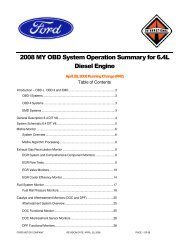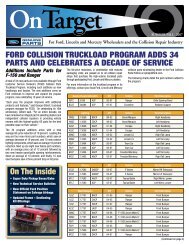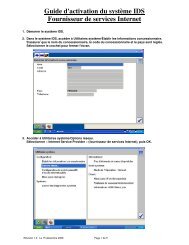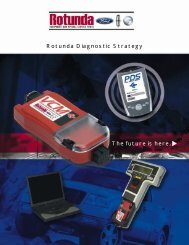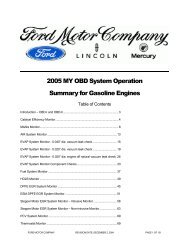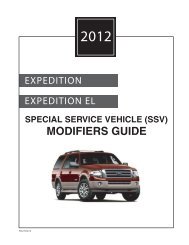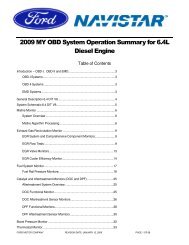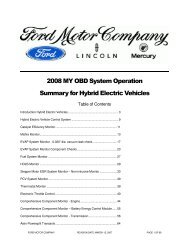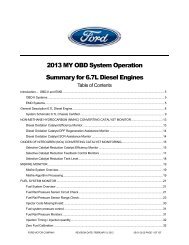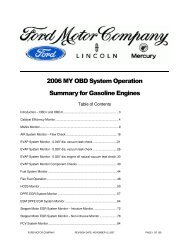OBD Operation Summary for Fiesta - MotorCraftService.com
OBD Operation Summary for Fiesta - MotorCraftService.com
OBD Operation Summary for Fiesta - MotorCraftService.com
- No tags were found...
Create successful ePaper yourself
Turn your PDF publications into a flip-book with our unique Google optimized e-Paper software.
Electronic Throttle Control (ETC) Motor Control CircuitThe ETC Motor Control Circuit diagnostics are able to detect a short circuit to power, a short circuit to ground and anopen circuit. The diagnostic is initialized after a module reset or a “Key ON”. After initialization (Key "ON"), the followingare all reset: The diagnostic conditions, the symptom, the counter, and the failure stored in the Error Management.The circuit diagnostics execute every 10 milliseconds and are continuous. A short circuit can only be detected when theH-bridge switches are open, so the condition <strong>for</strong> the each short circuit is calculated during all ranges of the PWM.The ETC motor control circuit diagnostic is activated between a battery voltage range. This is to eliminate false low limitvoltage detection. The deactivation threshold <strong>for</strong> the ETC motor control circuit diagnostic is typically calibrated to a lowvoltage.Spring check (start routine)This diagnostic checks if the throttle spring is working correctly and if the throttle limp home position can be achieved.The diagnostic is per<strong>for</strong>med at the beginning of every driving cycle at ignition "Key ON" position. The throttle body springcheck is executed as part of the start routine and is carried out with every “Key ON” of the engine control unit. Morespecifically the spring check is run during the TPS adaptation routine. The routine includes the following:• Limp-home position check• Adaptation of the limp-home position• Upper return spring checkThe start routine is only carried out when the adaptation conditions are maintained, (Key "ON" / Engine Running). Thediagnostic will report when a spring-check error occurs, which includes the upper or lower return spring limits.There is a throttle position set-point, calibratable, used <strong>for</strong> the upper return spring check. The TPS set-point should beapproximately 10 ° greater than the limp-home position.After the adaptation of the lower mechanical stop, the set point is used <strong>for</strong> the lower return spring check. The objective isto adjust the throttle in a position between the lower limit and limp-home. Without this set point, the throttle could stick inthe lower mechanical stop after the adaptation. A typical value of 2 ° is re<strong>com</strong>mended.ETC adaptation diagnosticAfter the initial engine start and / or <strong>com</strong>ponent change, the characteristic Potentiometer values <strong>for</strong> the limp homeposition and the lower mechanical stop are learned within an adaptation routine. The values are stored at the end of thedriving cycle in the non-volatile memory. If the conditions are not fulfilled, the malfunction errors (DTC's) are stored.Due to the electrical and mechanical tolerances of the ETC system, the sensor characteristic has to be learned and theETC system controller must adapt. The TPS adaptation is executed as part of the start routine and is carried out the veryfirst time there is a “Key ON” of the engine control unit at the vehicle assembly plant or when the engine control unit ischanged in service.CONTINENTAL REVISED: SEPTEMBER 17, 2010 PAGE 79 OF 111



